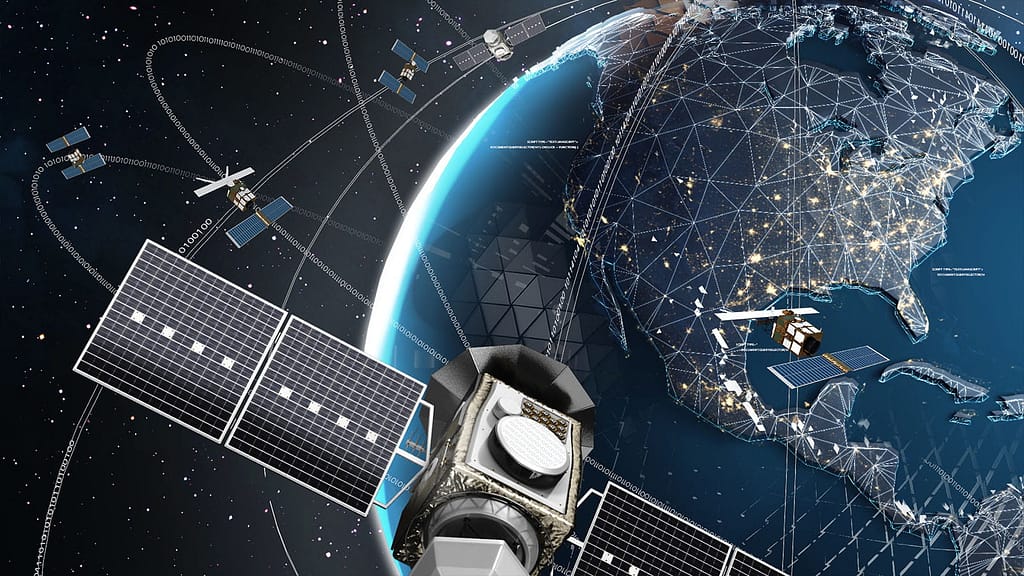In today’s rapidly evolving business landscape, environmental monitoring is becoming a quickly growing trend, adopted by worldwide companies across various industries. In this context, a common question is “How are satellites used in environmental monitoring?”
Satellite technology has proven invaluable in the field of IoT monitoring. In this article, we want to explore how are satellites used in environmental monitoring, examine the benefits and strategic implications for organizations, and give you an answer to this question.

How are satellites used in environmental monitoring?
Real-time data collection
Satellites play a crucial role in providing real-time data on environmental conditions. Understanding that is the first step to learning how satellites are used in environmental monitoring.
From tracking the movement of assets and monitoring air and water quality to assessing the impact of industrial activities, satellites offer businesses a comprehensive and up-to-date view of their environmental surroundings.
This real-time data allows companies to make informed decisions quickly, identify potential risks, and proactively address environmental challenges.
For businesses operating in industries with significant environmental implications, such as manufacturing, energy, and agriculture, leveraging satellite data enables them to stay ahead of regulatory requirements, reduce environmental liabilities, and enhance overall sustainability practices.
Risk mitigation and compliance
Environmental regulations are becoming increasingly stringent worldwide, with governments holding businesses accountable for their impact on the environment. Satellites provide a powerful tool for companies to monitor and assess their compliance with environmental regulations.
By utilizing satellite technology, businesses can identify areas of non-compliance, proactively address issues, and demonstrate their commitment to environmental responsibility.
Moreover, satellite data aids in risk mitigation by allowing companies to monitor environmental changes in their supply chains and operational areas. This proactive approach not only reduces the risk of regulatory penalties but also safeguards brand reputation and enhances stakeholder trust.
Resource management and efficiency
Satellite technology enables businesses to optimize resource management and operational efficiency.
For example, in the agriculture sector, satellites can provide valuable insights into crop health, soil moisture levels, and irrigation needs. This data allows farmers to implement precision agriculture techniques, reducing resource usage, minimizing waste, and improving overall productivity.
In the energy sector, satellites help monitor emissions, track changes in land and assess the impact of infrastructure projects.
By leveraging this type of information, businesses can implement more sustainable practices, enhance energy efficiency, and align their operations with global environmental goals.
Investment opportunities in earth observation services
As the demand for environmental monitoring grows, a new market for Earth observation services is emerging.
Companies specializing in satellite data analytics, interpretation, and reporting are becoming pivotal players in the business ecosystem. For investors, this presents opportunities to support and engage in businesses that provide essential environmental monitoring services.
In the future, this will become an entirely new market and a pivotal piece in the question: “How are satellites used in environmental monitoring?”

The importance of environmental monitoring
Environmental monitoring refers to the process of monitoring, assessing, and managing the environment of a company’s operations and activities.
An important example is energy consumption monitoring, in which companies track energy consumption in various forms, including electricity, fuel, heating, ventilation, and air conditioning (HVAC) systems to gather data and improve efficiency.
Implementing smart building technologies and energy-efficient practices, such as using energy-efficient appliances and adopting renewable energy sources, can contribute to reducing overall energy consumption.
Another pivotal application of environmental monitoring is supply chain assessment.
With companies increasingly recognizing the importance of assessing and improving the environmental performance of their entire supply chain, evaluating the environmental impact of sourcing raw materials, transportation methods, and the environmental practices of suppliers has become a main concern.
Challenges and future developments
While satellite-based environmental monitoring has demonstrated remarkable capabilities, certain challenges have prompted the need for continuous innovation and improvement.
Historically, the expense associated with launching and maintaining satellites has been a barrier to widespread adoption. However, the industry is witnessing a positive shift with the development of smaller, more cost-effective satellites known as CubeSats.
These miniature satellites are reducing the overall financial burden, making satellite technology more accessible for governments, research institutions, and even private enterprises.
Despite the wealth of information gathered by satellites, ensuring open access to this data remains a challenge. To address this, initiatives like the Group on Earth Observations (GEO) have been working to facilitate the sharing of environmental data on a global scale.
Increased collaboration between nations and the establishment of data-sharing protocols contribute to overcoming the accessibility hurdle, promoting a more inclusive and comprehensive approach to environmental monitoring.
Rapid advancements in satellite technology are continuously overcoming technical limitations. Improved sensors with higher resolution capabilities enable more detailed observations, allowing for finer analysis of environmental changes.
Additionally, innovations in data processing techniques enhance the efficiency of extracting meaningful insights from the vast amounts of data collected by satellites.
But looking ahead, the field of environmental monitoring through satellite technology is poised for significant growth and evolution.
Future endeavors in environmental tracking will likely witness increased collaboration among governments, private companies, and research institutions.
Collaborative efforts can pool resources, share expertise, and collectively address global environmental challenges. Partnerships may lead to the development of advanced satellite constellations, ensuring comprehensive coverage and robust data collection.
The convergence of satellite technology with emerging technologies, such as artificial intelligence (AI) and machine learning (ML), holds immense promise. AI and ML algorithms can analyze vast datasets with unprecedented speed and accuracy, extracting meaningful patterns and trends.
Integration with these technologies enhances the capabilities of environmental tracking systems, allowing for more precise monitoring and predictive analysis.
As the utilization of satellite technology for environmental monitoring becomes more widespread, the development of comprehensive space policies and regulations becomes imperative.
Governments and international bodies need to establish guidelines for responsible satellite usage, data sharing, and environmental monitoring practices to ensure ethical and sustainable applications.

Take the first step into the future with Datanet IoT
While challenges persist, the trajectory of satellite-based environmental tracking solutions is undeniably optimistic and is an important aspect of how are satellites used in environmental monitoring.
The combination of cost-effective satellite technologies, improved data accessibility, and the integration of cutting-edge advancements positions satellite-based monitoring as a cornerstone of future business models.
If you want to take a step into the future and start implementing environmental monitoring systems in your company, we here at Datanet IoT are ready to help you in this endeavor. Our solutions are developed to bring the best in environmental monitoring technology with a wide array of applications for many different sectors.
So don’t waste any more time. Get in contact today to learn about our products and schedule a demonstration!







